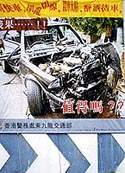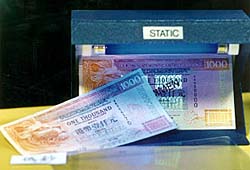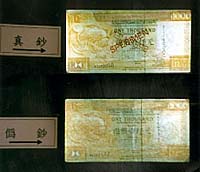



















 . . . but even one traffic fatality is one too many |
THE enhanced awareness of road users about road safety is one of the major factors contributing to the decrease in traffic accidents and casualties in the second half of 1998, said Chief Superintendent, Traffic Headquarters, Lai Pak-hay. Speaking at a recent press conference to review the traffic accident situation in the last six months of 1998, CSP Lai said the total number of accidents involving personal injury in the period decreased by 2.9 per cent to 7,116 cases compared with the corresponding period of 1997. Accidents on Kowloon East and Hong Kong Island dropped significantly during the period, he said. |
|
Mr Lai pointed out that following too closely to vehicles in front remained the most common contributing factor (7.16 per cent) to traffic accidents. During the period under review, fatal traffic accidents decreased by 7.1 per cent to 105 cases from 113 in the same period of 1997 while overall injury accidents decreased by 2.9 per cent from 7,328 cases to 7,116. Of the fatalities claiming 114 lives, 50.9 per cent or 58 were pedestrians, indicating that they were most vulnerable to accidental deaths on the road. Drivers, motorcyclists, cyclists and passengers accounted for 49.1 per cent or 56 of the total fatalities. Mr Lai reminded all pedestrians that they could minimise their exposure to risk by using underpasses, footbridges, zebra and controlled crossings. "Motorists should always watch out for pedestrian crossings or on carriageways, and reduce their speed accordingly with regard to the road conditions," he added. Turning to accidents on expressways, Mr Lai noted that Tuen Mun Road and the Island Eastern Corridor recorded 27.5 and 24.1 per cent decreases in traffic accidents with 53.8 and 11.5 per cent decreases in casualties respectively. Tolo Highway showed a 1.2 per cent decrease in traffic accidents despite a 8.5 per cent rise in casualties. Accidents involving public buses showed a slight increase of 4.6 per cent from 823 cases to 861 cases when compared with the corresponding period. "A study into the bus accidents revealed that 'sudden stopping/starting' was the main cause of the accidents," Mr Lai said. "Enforcement actions against public bus drivers increased significantly by 10.4 per cent. The majority of the drivers were prosecuted for speeding, careless driving, disobeying traffic signals and traffic signs offences." Traffic enforcement activities in the last six months of 1998 decreased by 28.2 per cent. Speeding still accounted for the majority of the enforcement against drivers. A total of 97,005 speeding offences were recorded during the period, representing a drop of 5.6 per cent. A police study showed that about 9 per cent of night time accidents had a drink driving factor. Since the introduction of drink driving legislation on 15 December 95, Police have breathalysed a total 55,219 drivers with 5,049 or 9.1 per cent found to have consumed alcohol. Of the 55,219 drivers, 2,736 were found to have an alcohol level over the prescribed limit, representing a hit rate of 5 per cent. "A total of 1,711 drivers were convicted of drink driving offences, resulting in fines ranging from $1,000 to $12,500 and disqualification from one month to 48 months. Five drivers were sentenced to imprisonment of 21 days to two months," Mr Lai noted. In 1997 and 1998, 87 persons were prosecuted for rear seat belt offences relating to the private cars. "To enhance the public awareness of the importance of wearing seat belts, seat belt offences have been included in the Selective Traffic Enforcement Policy since July last year. As a result, during the second half of 1998, 9,153 fixed penalty tickets were issued," Mr Lai said. In the last six months of 1998, 8,384 prosecutions of overloading offences were recorded, which represented a drop of 25.1 per cent in the same period of 1997. "Enhanced awareness of safe loading among goods vehicle drivers helped to bring about a significant decrease in prosecution cases on insecure loading from 5,076 to 3,414, representing a drop of 32.7 per cent,"Ó he said. | |
|
POLICE are urging members of the public to
report any counterfeit banknotes they come across following a slight increase in the number of
phoney $500 and $1,000 notes at the close of 1998.
Reviewing the counterfeit notes which surfaced in 1998, Superintendent of the Commercial Crime Bureau, Kenneth Reed, said that although the number of counterfeit banknotes circulating locally had not brought about a detrimental effect on the economy, Hong Kong Police have been closely monitoring the trend. "We are determined to tackle counterfeiting at its source and have been actively investigating reports of counterfeit banknotes," he said. |  A bogus $1000 note in front of the real thing |
|
Counterfeit $500 banknotes that have come to the attention of police increased from 127 in 1997 to 331 last year while counterfeit $1,000 bills rose to 2,634 last year from 1,982 in 1997. A drop, however, was seen in the number of counterfeit $100 backnotes from 2,555 in 1997 to 1,710 last year. "Anyone who knowingly counterfeits, passes or keeps a counterfeit note may be liable to prosecution and on conviction can face a maximum penalty of 14 years imprisonment under the Crimes Ordinance," Mr Reed warned. "If anyone receives a counterfeit note, he/she should either report it to the police or hand it in to a bank. Highlighting some common tactics employed by utterers of counterfeit notes in their attempts to pass the notes, Mr Reed said that they usually handed out the notes folded to hide a counterfeit feature. "Unfolding the note in full to inspect it closely will help to reduce the risk of being deceived," he advised. Superintendent Reed urged shop keepers and cashiers to be aware of people making small purchases using large denomination notes: "If in doubt, compare the notes against a real one as counterfeit features are very obvious." SP Reed noted that there were a number of different types of counterfeit notes. "Some are better than others ¡Ð but all can easily be detected if one takes the time to examine them carefully. There are a number of more obvious features of counterfeit banknotes that consumers can be on the lookout for, such as the quality of the counterfeit paper which is never as good as that of real notes. Some counterfeits are formed by gluing two pieces of paper together, which inevitably makes them thicker than normal notes. The printing processes used by counterfeiters are also different to that used by a legitimate note manufacturing company, producing counterfeit notes that feel smoother when touched. | |
 "If in doubt, compare the notes against a real one as counterfeit features are very obvious" |
Additionally, most counterfeits simulate the watermark by printing, which means it will become visible when placed under ultra-violet light. Other tell-tale signs of bogus bills are the poor alignment of the serial numbers and, when viewed against the light, most counterfeit notes do not align the see through features on the front and back of the notes, "blurring" the image of the notes. In 1998, there were 62 persons arrested in connection with counterfeit backnotes. Of them, 18 were prosecuted. |

